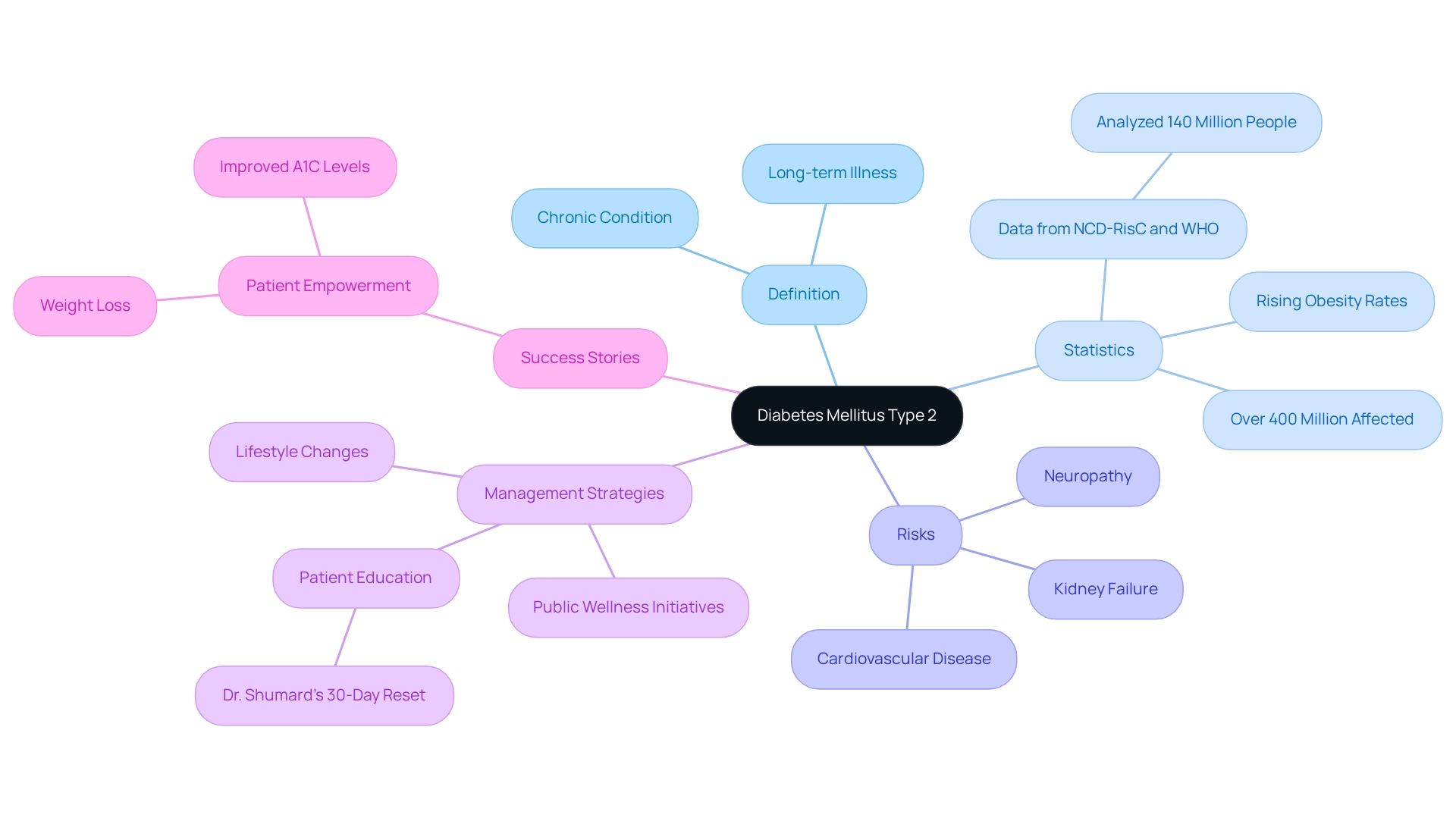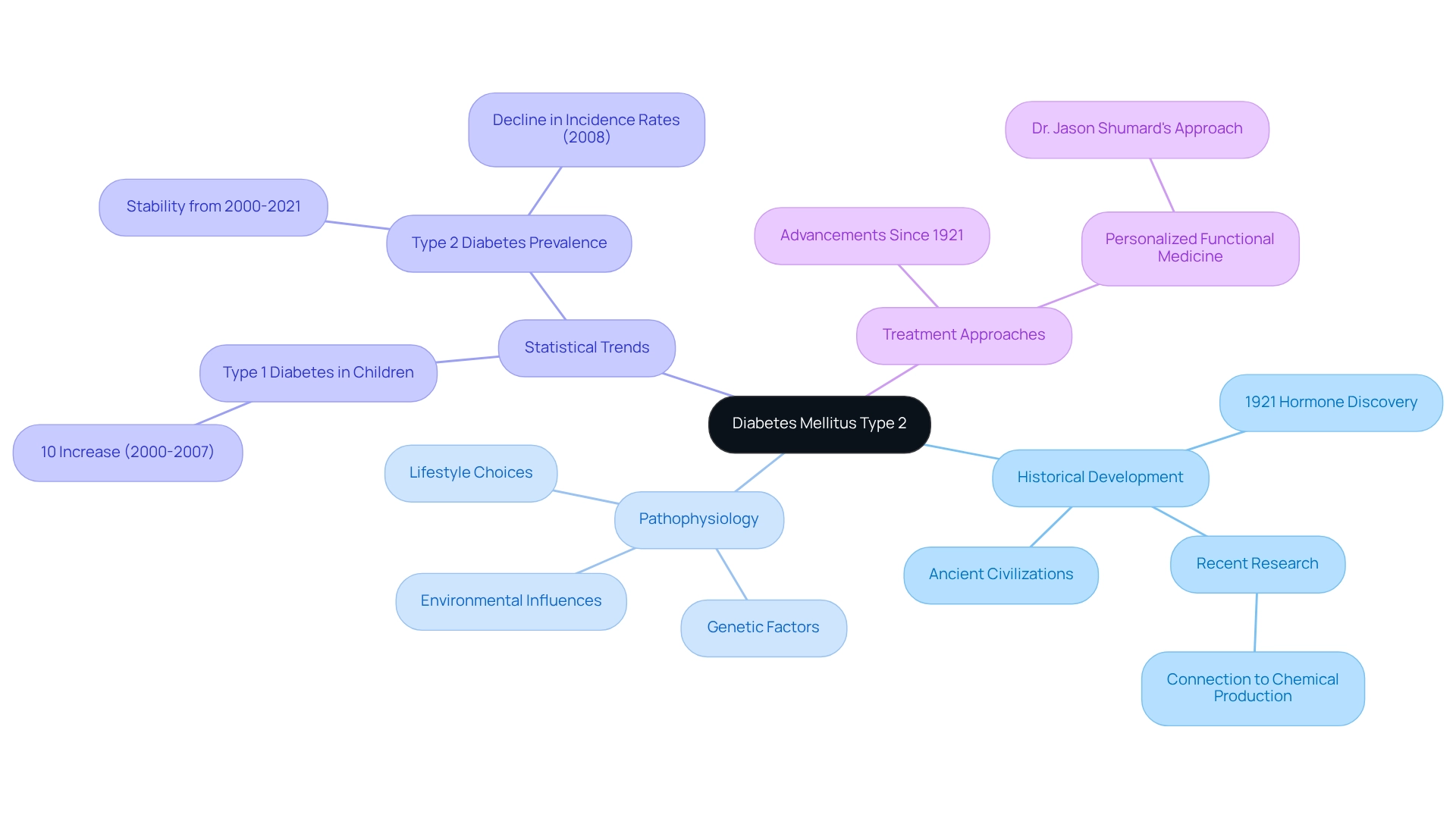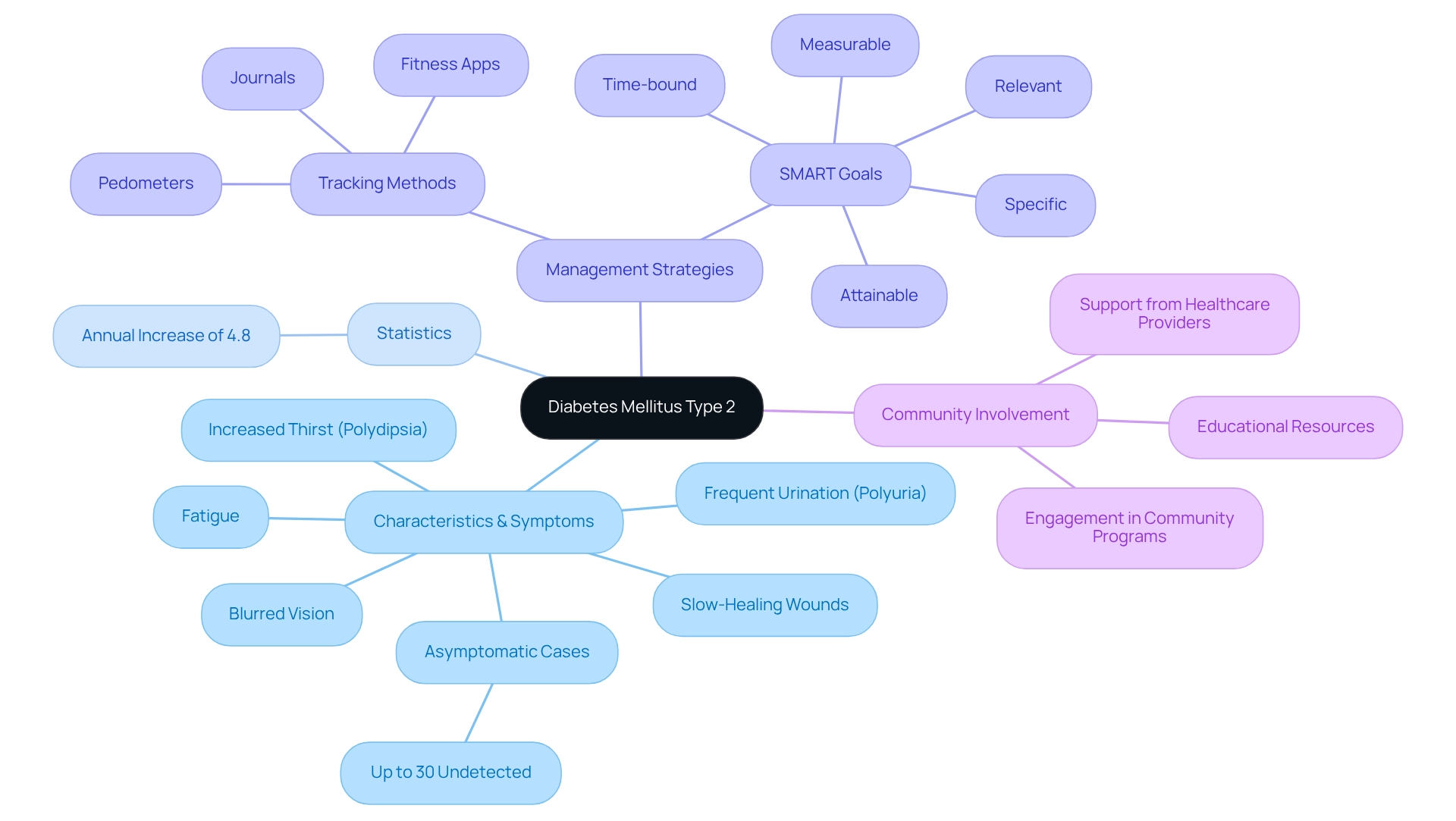Overview
Diabetes Mellitus Type 2 is a chronic metabolic condition that many individuals face, characterized by elevated blood sugar levels. This often stems from insulin resistance and a relative lack of insulin, frequently linked to obesity and sedentary lifestyles. It’s important to recognize that understanding this condition is crucial for those affected. The prevalence rates are alarming, highlighting the pressing need for targeted health initiatives. Many patients find that lifestyle changes and personalized treatment plans can significantly impact their well-being.
As you navigate this journey, remember that you’re not alone. There are effective ways to manage and even reverse the effects of this condition. Embracing a healthier lifestyle can be transformative, and we encourage you to explore the 30-Day Diabetes Reset program. This initiative offers guidance and support tailored to your needs, helping you take actionable steps toward better health.
Your experience matters, and with the right resources, you can make positive changes. Together, let’s work toward a healthier future where Diabetes Mellitus Type 2 doesn’t define you, but rather motivates you to thrive.
Introduction
In a world where chronic diseases are increasingly prevalent, diabetes mellitus type 2 emerges as a significant public health concern, impacting over 400 million individuals worldwide. This complex condition, marked by insulin resistance and elevated blood sugar levels, is deeply intertwined with lifestyle choices, obesity, and genetic factors. It’s important to recognize that as the prevalence of this disease continues to rise, understanding its underlying mechanisms and effective management strategies becomes essential for many.
Many patients find that the journey toward reclaiming health is filled with transformative possibilities. From the historical evolution of diabetes treatments to innovative functional medicine approaches, there are numerous avenues to explore. By delving into the multifaceted nature of type 2 diabetes, individuals can empower themselves with the knowledge and resources necessary to combat this chronic illness.
Ultimately, improving overall well-being is within reach. Are you ready to take the first step? Together, we can navigate this path toward a healthier future.
Define Diabetes Mellitus Type 2
The definition of diabetes mellitus type 2 refers to a persistent metabolic condition that can significantly impact one’s life, characterized by increased blood sugar levels due to resistance to insulin and a relative shortage of this hormone. The definition of diabetes mellitus type 2 differs from type 1 diabetes, as it occurs when the body’s cells become less sensitive to insulin, resulting in a buildup of glucose in the bloodstream, unlike type 1 where the pancreas produces little to no insulin. This condition is often linked to obesity, a sedentary lifestyle, and genetic factors, making it a pressing public concern worldwide.
As we look ahead to 2025, it’s estimated that around 537 million adults globally will be diagnosed with type 2 diabetes, with prevalence rates varying significantly across different demographics. For instance, among Hispanic, Latino, or Spanish adults, the prevalence ranges from 5.0% to 7.3%. These figures highlight the urgent need for culturally tailored wellness interventions to meet the diverse needs of various populations. Additionally, American Indians and Alaskan Natives face the highest rates at 13.6%, further emphasizing the importance of targeted health initiatives to address these disparities.
The definition of diabetes mellitus type 2 includes key characteristics such as increased thirst, frequent urination, fatigue, and blurred vision. It’s important to recognize that this condition is frequently associated with insulin resistance, which means the body’s cells struggle to use insulin effectively. This can lead to additional complications, such as high blood pressure, which affects over 71% of U.S. adults grappling with blood sugar regulation problems. Recent research underscores the significance of addressing insulin resistance through lifestyle modifications and functional medicine approaches, focusing on treating underlying causes rather than merely managing symptoms.
Many patients find that there is hope for reversing type 2 diabetes through functional medicine, particularly via Dr. Jason Shumard’s 30-Day Reset program. Patients have shared transformative experiences, including significant weight loss, improved blood sugar levels, and reduced reliance on medications. For example, one patient expressed, “I lost 55 lbs. My A1C started at 9.1 after 8 months; it is now 5.7.” These testimonials highlight the effectiveness of personalized treatment plans that empower individuals to take control of their health.
By understanding the complexities of insulin resistance and the various characteristics that contribute to the definition of diabetes mellitus type 2, individuals can make informed choices about their treatment options and enhance their overall wellness. Moreover, corporate health programs can provide essential resources for managing diabetes in the workplace, offering additional support to those affected. Together, we can foster a community of understanding and proactive health management.
Context and Importance of Diabetes Mellitus Type 2
The definition of diabetes mellitus type 2 indicates that it is a widespread long-term illness, currently impacting over 400 million people globally, as reported by the NCD Risk Factor Collaboration (NCD-RisC). This alarming statistic is compounded by rising obesity rates and increasingly sedentary lifestyles, particularly in developed countries. A study analyzing data from over 140 million people, conducted by NCD-RisC in collaboration with WHO, highlights these concerning trends. The definition of diabetes mellitus type 2 includes significant risks, such as cardiovascular disease, kidney failure, and neuropathy. These complications lead to rising healthcare expenses and a diminished quality of life for those affected.
As we approach 2025, the worldwide occurrence of diabetes mellitus type 2, defined as a chronic condition, continues to rise, necessitating urgent public wellness measures. It’s important to recognize that recent studies indicate significant changes in lifestyle and healthcare approaches are essential to reverse these trends. Effective management and prevention strategies are vital to mitigate the adverse effects of this condition, making awareness and education critical elements of public well-being initiatives.
Many patients find that effective public wellness initiatives significantly enhance awareness regarding blood sugar conditions. This awareness is crucial in informing communities about the connections between obesity and the definition of diabetes mellitus type 2. Case studies reveal that enhanced knowledge empowers individuals to take proactive measures in managing their health, ultimately leading to improved outcomes. For instance, patients who have participated in Dr. Shumard’s 30-Day Diabetes Reset program report transformative experiences, such as substantial weight loss and improved A1C levels. One patient shared, “I lost 55 lbs. My A1C started at 9.1, and after 8 months, it is now 5.7.” This highlights the program’s effectiveness in reversing symptoms and enhancing overall well-being.
Expert insights emphasize that understanding the definition of diabetes mellitus type 2 and addressing its increasing occurrence is essential for improving public welfare and alleviating the strain on healthcare systems worldwide. As pointed out by Shivani Agarwal, MD, MPH, “A central focus and understanding of inequity in blood sugar disorders is vital to achieve the UN’s Sustainable Development Goal to reduce non-communicable diseases by 30% in less than 7 years.” This underscores the essential need for targeted public wellness initiatives that address inequalities in blood sugar management and prevention, alongside innovative methods like those provided by Dr. Shumard.
If you are ready to take charge of your health and explore effective solutions for managing type 2 diabetes, reach out to Dr. Shumard today to learn more about the 30-Day Reset program and how it can transform your life.
Historical Development and Pathophysiology of Diabetes Mellitus Type 2
The history of this condition traces back to ancient civilizations, with the term derived from the Greek word meaning ‘siphon,’ referring to the frequent urination characteristic of the ailment. Notable advancements in understanding this condition emerged in the early 20th century, particularly with the groundbreaking discovery of a key hormone in 1921, which transformed treatment options; the definition of diabetes mellitus type 2 encompasses a complex interplay of genetic factors, environmental influences, and lifestyle choices that lead to resistance to insulin and insufficient secretion. Over time, the pancreas may struggle to produce enough insulin, resulting in persistent high blood sugar levels and a range of complications. It’s important to recognize that recent research highlights a concerning surge in the prevalence of this condition alongside industrial chemical production, suggesting a potential connection between environmental factors and the illness. However, correlation does not imply causation, and understanding this nuance is vital.
Historical statistics reveal a significant evolution in the incidence of this illness over the decades. Notably, there was a stability in diagnosed cases among U.S. adults from 2000 to 2021, followed by a decline in incidence rates starting in 2008. This trend may indicate advancements in managing and preventing the condition, as shown in the case study titled ‘Trends in Diabetes Incidence Among Adults.’ Yet, careful interpretation of data is necessary due to changes in survey methodologies. Furthermore, it’s important to acknowledge that the occurrence of type 1 diabetes in children rose by 10% from 2000 to 2007, underscoring the broader context of sugar-related trends. Insights from researchers emphasize the significance of understanding the definition of diabetes mellitus type 2, as it relates to the fundamental mechanisms of the disease, while progress in treatment continues to evolve since the advent of insulin. Dr. Jason Shumard, who holds postgraduate education in functional endocrinology and clinical nutrition, shares, ‘By providing patients with actionable insights and practical tools, the center fosters an environment where individuals can reclaim their health and well-being.’ His approach at the Integrative Wellness Center, which he founded in 2005, focuses on personalized functional medicine strategies that address the underlying issues of type 2 metabolic disorder, empowering patients through tailored nutrition and lifestyle changes.
The ongoing exploration of the disease’s pathophysiology is crucial for developing effective management strategies and improving patient outcomes. Notable progress in managing blood sugar conditions since 1921 has paved the way for improved treatment options, further enhancing the quality of care for patients. If you’re seeking support on your journey to better health, consider reaching out to the Integrative Wellness Center today to learn how Dr. Shumard can assist you in reversing your condition.
Key Characteristics and Symptoms of Diabetes Mellitus Type 2
The definition of diabetes mellitus type 2 describes a challenging condition marked by persistent hyperglycemia, insulin resistance, and often, obesity. Many individuals may experience symptoms such as increased thirst (polydipsia), frequent urination (polyuria), fatigue, blurred vision, and slow-healing wounds. It’s important to recognize that a significant percentage of individuals may remain asymptomatic in the early stages—estimates suggest that up to 30% of cases can go undetected. This reality underscores the necessity of regular screenings for timely diagnosis. Statistics reveal that the annual relative increase in type 2 cases is approximately 4.8 percent, highlighting the growing prevalence of this condition. Early diagnosis is crucial, as it allows for effective management strategies that can significantly improve health outcomes.
Many patients find that real-life examples demonstrate the empowerment they can achieve in managing their symptoms. Community involvement programs, like seminars and activities arranged by Dr. Shumard’s center, provide participants with complimentary educational resources, enhancing their understanding of diabetes management. This proactive approach fosters a supportive environment where individuals can reclaim their health. Expert insights emphasize the importance of recognizing key symptoms; as noted by the CDC, “Type 2 is rare for children of all racial and ethnic backgrounds,” highlighting the need for awareness across all demographics.
To effectively monitor and enhance progress in managing blood sugar levels, individuals are encouraged to utilize various tracking methods, including fitness apps, journals, and pedometers. Implementing SMART goals—specific, measurable, attainable, relevant, and time-bound—can enhance focus and motivation. For instance, a patient might set a target to maintain their blood sugar levels within a specific range or gradually increase their physical activity. Regularly reviewing one’s progress fosters accountability and allows for the adaptation of goals in response to changing health conditions. By maintaining healthy levels of cholesterol, blood pressure, and blood sugar, individuals can effectively reduce their risk of developing diabetes. This reinforces the value of education and awareness in combating this chronic disease.
Here are some key tips to consider:
- Stay informed about your condition and seek support from healthcare providers.
- Engage in community programs that promote health and wellness.
- Set realistic goals and track your progress.
Remember, you are not alone in this journey, and with the right support and resources, you can take proactive steps toward better health.
Conclusion
Understanding diabetes mellitus type 2 is crucial, as it represents a significant public health challenge affecting over 400 million people globally. This condition, characterized by insulin resistance and elevated blood sugar levels, is often linked to obesity and lifestyle factors. With the prevalence of this disease on the rise, it’s important to recognize the significance of early diagnosis, lifestyle modifications, and personalized treatment strategies.
The journey toward managing and potentially reversing type 2 diabetes is filled with transformative possibilities. Many individuals find hope through innovative programs like Dr. Jason Shumard’s 30-Day Diabetes Reset. Participants often experience significant improvements in their health, including weight loss and better blood sugar control. These success stories highlight the power of functional medicine approaches that focus on the root causes of the disease rather than merely managing symptoms.
Ultimately, empowering individuals with knowledge and resources is key to combating type 2 diabetes. By fostering a deeper understanding of the condition and encouraging proactive health management, communities can work together to address this chronic illness effectively. The path toward improved well-being is within reach. Remember, taking that first step can lead to a healthier future for all.
Frequently Asked Questions
What is diabetes mellitus type 2?
Diabetes mellitus type 2 is a persistent metabolic condition characterized by increased blood sugar levels due to insulin resistance and a relative shortage of insulin. It differs from type 1 diabetes, where the pancreas produces little to no insulin.
What causes diabetes mellitus type 2?
The condition is often linked to obesity, a sedentary lifestyle, and genetic factors.
How prevalent is diabetes mellitus type 2 globally?
By 2025, it is estimated that around 537 million adults worldwide will be diagnosed with type 2 diabetes, with prevalence rates varying significantly across different demographics.
Which populations are most affected by diabetes mellitus type 2?
Among Hispanic, Latino, or Spanish adults, prevalence ranges from 5.0% to 7.3%, while American Indians and Alaskan Natives have the highest rates at 13.6%.
What are the key characteristics of diabetes mellitus type 2?
Key characteristics include increased thirst, frequent urination, fatigue, and blurred vision, often associated with insulin resistance.
What complications can arise from diabetes mellitus type 2?
Complications can include high blood pressure, which affects over 71% of U.S. adults with blood sugar regulation problems.
How can diabetes mellitus type 2 be managed or reversed?
Many patients find hope in reversing type 2 diabetes through functional medicine approaches, such as Dr. Jason Shumard’s 30-Day Reset program, which emphasizes lifestyle modifications and personalized treatment plans.
What success stories exist regarding the management of diabetes mellitus type 2?
Patients have reported transformative experiences, such as significant weight loss and improved blood sugar levels, with one patient losing 55 lbs and reducing their A1C from 9.1 to 5.7.
How can individuals improve their understanding and management of diabetes mellitus type 2?
By understanding insulin resistance and the characteristics of diabetes mellitus type 2, individuals can make informed choices about their treatment options and enhance their overall wellness.
What role can corporate health programs play in managing diabetes?
Corporate health programs can provide essential resources and support for managing diabetes in the workplace, fostering a community of understanding and proactive health management.



